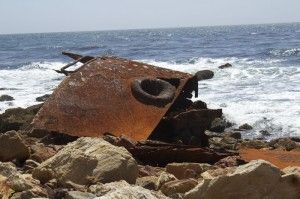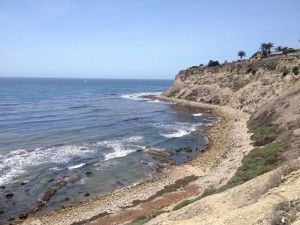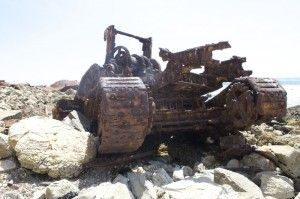Among the different kinds of hikes at the disposal of any adventure-seeking Southern California resident, beach hikes are my personal favorite. The calming ocean breeze, the gorgeous views, and the mild seaside climate all enhance the hiking experience. What makes a beach hike even better is finding the massive remains of a 50 year-old shipwreck.

While some may prefer looking for small seashells on soft sand beaches, those interested in a more rugged beach experience should head to the coast of Rancho Palos Verdes. There the rusted skeleton of the SS Dominator remains impaled on the very same jagged coastline that dealt the Greek freighter its final blow.
Used as a freighter during WWII, the SS Dominator originally bore the American flag and was launched into service in March 1944. After the war, it was sold into commercial service and was operated by U.S., Panamanian and eventually Greek crews. In 1961, the Dominator was delivering a shipment of wheat and beef from Vancouver to Los Angeles when it ran aground due to foggy conditions. After several failed attempts to rescue the beached vessel, the ship was abandoned and its cargo salvaged. While no one was killed in the wreck, it is easy to let one’s imagination run wild when approaching the scattered remains of the Dominator, which has the eerie aura of a watery grave.
There is no terribly easy way to access the shipwreck. The rough and rocky beach that wraps around the mansion-encrusted Palos Verdes peninsula is separated from the mainland by nearly vertical sandstone cliffs. Luckily, there is a makeshift trail carved out of the side of the cliff face that facilitates the descent.
To access the trail, hikers can park their car on the corner of Paseo Del Mar and Avenida Mirola in Rancho Palos Verdes for free. From that location, they can walk north along the cliff side until they spot a small wooden post sticking about two feet out of the ground. The wooden post should come into view in just a matter of minutes. This post marks the location of the “staircase.”
While this descent is safer than literally falling off a cliff, it is still difficult and slightly dangerous. The rock is fragile and chalky at times and is absolutely want to give way in response to any false step. You have been warned.

The hike along the beach is anything but relaxing. Keep in mind that this is the same coastline that cut through the hull of a ship. This isn’t the kind of beach to which you bring flip-flops and a towel. The rocks are plentiful, slippery and sharp and that isn’t even including the portion scattered with rusted metal.
Speaking of which…
After traversing the coastline due north for a bit, hikers will come across a bunker-like structure that would probably be the coolest place in the world to have beach barbecue. However, about half a mile beyond that, the first rusting chunk of metal that once was the Dominator will come into view on the horizon.
The last half-century has not been kind to the grounded ship. These 50-plus years have been kinder to Keith Richards, but the remains are still a lot of fun to explore. The first chunk of hull is what may have been the bow of the ship. There is a large circular hole in the metal piece, which may have been the location of the ship’s anchor. Further down the beach, more and more pieces of the ship begin to become visible. Here, the rocks are larger, more slippery and thus more dangerous. Also, the surface of every rock at the wreck site has seemingly been painted with a layer of rust due to the incessant washing of the tide over the years. If there ever was a place called “Tetanus Beach,” this would be the place, and with how slick the rocks are, extreme caution is advised when walking around the shipwreck. This is the kind of place in which one scraped knee could lead to hours in a hospital, or worse.

As the expanse of wreckage comes closer into view, certain pieces of ship become recognizable. The main mast of the ship still remains intact as one long metal pipe and gears and rotaries of various mechanical equipment blend in the with the rust-washed terrain. The most curious piece of equipment on the beach is what once was either a bulldozer or a crane of some kind. It has identifiable caterpillar tracks on either side and what used to be a cockpit, but the machinery’s former function is a mystery to an eye as untrained as mine. My best guess is that it was either used as a loading mechanism for lifting cargo crates onto the Dominator, or it was a wrecked piece of cleanup equipment left over from the crew that attempted to move the ship back into the water. Regardless, this piece of wreckage is sturdy and can be climbed upon, but only with caution as the entire hulking construct is covered in thick rust.
While it’s no Titanic, this shipwreck is as interesting as any you’ll find on dry land and well worth the short hour long drive from UC Irvine.
Take a look for yourselves.




